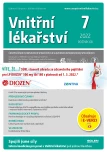New developments in anaemia treatment – erythropoietin versus prolyl hydroxylase inhibitors?
Authors:
Romana Ryšavá 1,2
Authors‘ workplace:
Klinika nefrologie, 1. LF UK a VFN, Praha
1; Interní klinika 1. LF UK a ÚVN, Praha
2
Published in:
Vnitř Lék 2022; 68(7): 438-443
Category:
Main Topic
doi:
https://doi.org/10.36290/vnl.2022.092
Overview
Anaemia is a very common complication of chronic kidney disease (CKD) and renal failure. The view of the treatment of anaemia has changed considerably since the introduction of ESAs (erythropoiesis-stimulating agents) into clinical practice, and the safety of this treatment is now prioritised over complete normalisation of haemoglobin (Hb) values. Iron administration is the mainstay of treatment in this group of patients, with intravenous administration proving to be both more effective and safer in both predialysis and dialysis patients. In addition to the long-used ESAs, a number of new agents developed to favourably influence erythropoiesis have recently been tested for the correction of anaemia. Among those with the greatest potential are the HIF-stabilizers (roxadustat, molidustat, vadadustat and daprodustat), which act through stimulation of erythropoiesis genes and thus represent a novel mechanism of action in the treatment of anaemia. In phase 3 clinical trials, these agents have shown the same efficacy in increasing Hb levels as ESAs, but much emphasis has recently been placed on their safety profile. They are orally administered agents and some of them are already approved and used in clinical practice. The first of these, roxadustat, is currently reimbursed also in the Czech Republic. Other molecules affecting anaemia, such as sotatercept, have also been confirmed to be effective in phase 1 and 2 clinical trials and are awaiting results from larger randomised trials.
Keywords:
dialysis – anaemia – chronic kidney disease – haemoglobin – ESA – HIF‑stabilizers
Sources
1. McClellan W, Aronoff SL, Bolton WK et al. The prevalence of anemia in patients with chronic kidney disease. Curr Med Res Opin. 2004;20:1501-1510.
2. Stauffer ME, Fan T. Prevalence of anemia in chronic kidney disease in the United States. PLoS One. 2014;9:e84943.
3. KDOQI Clinical Practice Guidelines and Clinical Practice Recommendations for Anemia in Chronic Kideny Disease. AJKD 2006; 47(Suppl 3):S1-S146.
4. KDIGO Clinical Practice Guideline for Anemia in Chronic Kidney Disease. Kidney Int Suppl 2012;2:283-287.
5. Singh AK, Szczech L, Tang KL et al. Correction of anemia with epoetin alfa in chronic kidney disease (CHOIR). N Engl J Med. 2006;355:2085-2098.
6. Drüeke TB, Locatelli F, Clyne N et al. Normalization of hemoglobin level in patients with chronic kidney disease and anemia. N Engl J med. 2006;355:2071-2084. (CREATE study).
7. Pfeffer MA, Burdmann EA, Chen ChY et al. A Trial of Darbepoetin Alfa in Type 2 Diabetes and Chronic Kidney Disease (TREAT). N Engl J Med. 2009;361:2019-2032.
8. Besarab A, Bollon WK, Browne JK et al. The effects of normal as compared with low hematocrit values in patients with cardiac disease who are receiving hemodialysis and epoetin. N Engl J Med. 1998;27;339(9):584-590.
9. Coyne DW, Goldsmith D, Macdougall IC. New options for the anemia of chronic kidney disease. Kidney Int Suppl. 2017;7:157-163.
10. Fishbane S, Besarab A. Mechanism of increased mortality risk with erythropoietin treatment to higher hemoglobin targets. Clin J Am Soc Nephrol. 2007;2:1274-1282.
11. Fishbane S, Schiller B, Locatelli F et al. Peginesatide in patients with anemia undergoing hemodialysis. N Engl J Med. 2013;368(4):307-19.
12. Macdougall IC, Provenzano R, Sharma A et al. Peginesatide for anemia in patients with chronic kidney disease not receiving dialysis. N Engl J Med. 2013; 368(4):320-32.
13. Jelkmann W. Regulation of erythropoietin production. J Physiol. 2011;589:1251-1258.
14. Haase VH. Hypoxia‑inducible factor)prolyl hydroxylase inhibitors in the treatment of anemia of chronic kidney disease. Kideny Int Suppl. 2021;11:8-25.
15. Sanghani NS, Haase VH. HIF‑prolyl hydroxylase inhibitors in renal anemia: current clinical experience. Adv Chronic Kidney Dis. 2019;26(4):253-266.
16. Wagner M, Alam A, Zimmermann J et al. Endogenous erythropoietin and the association with inflammation and mortality in diabetic chronic kidney disease. Clin J Am Soc Nephrol. 2011;6:1573-1579.
17. Bernhardt WM, Wiesener MS, Scigalla P et al. Inhibition of prolylhydroxylases increases erythropoietin production in ESRD. J Am Soc Nephrol. 2010;21:2151-2156.
18. Agarwal AK. Iron metabolism and management: focus on chronic kidney disease. Kidney Int Suppl. 2021;11:46-57.
19. Besarab A, Chernyavskaya E, Motylev I et al. Roxadustat (FG-4592): correction of anemia in incident dialysis patients. J Am Soc Nephrol. 2016;27:1225-1233.
20. Taylor CT, Doherty G, Fallon PG et al. Hypoxia‑dependent regulation of inflammatory pathways in immune cells. J Clin Invest. 2016;126:3716-3724.
21. Barrat J, Sulowitcz W, Schömig M et al. Efficacy and cardiovascular safety of roxadustat in dialysis‑dependent chronic kidney disease: pooled analysis of four phase 3 studies. Adv Ther. 2021;38:5345-5360.
22. Jelkmann W. The ESA scenario gets complex: from biosimilar epoetins to activin traps. Nephrol Dial Transplant. 2015;30(4):553-559.
23. Coyne DW, Singh HN, Smith WT et al. Sotatercept safety and effects oh hemoglobin, bone, and vascular calcification. Kidney Int Reports. 2019;4:1585-1597.
Labels
Diabetology Endocrinology Internal medicineArticle was published in
Internal Medicine

2022 Issue 7
Most read in this issue
- Reactive, infectious, or post‑infectious arthritis?
- Thyroid incidentalomas
- New developments in anaemia treatment – erythropoietin versus prolyl hydroxylase inhibitors?
- New technology in the hypolipidemic drugs development. Inclisiran (LEQVIO)
